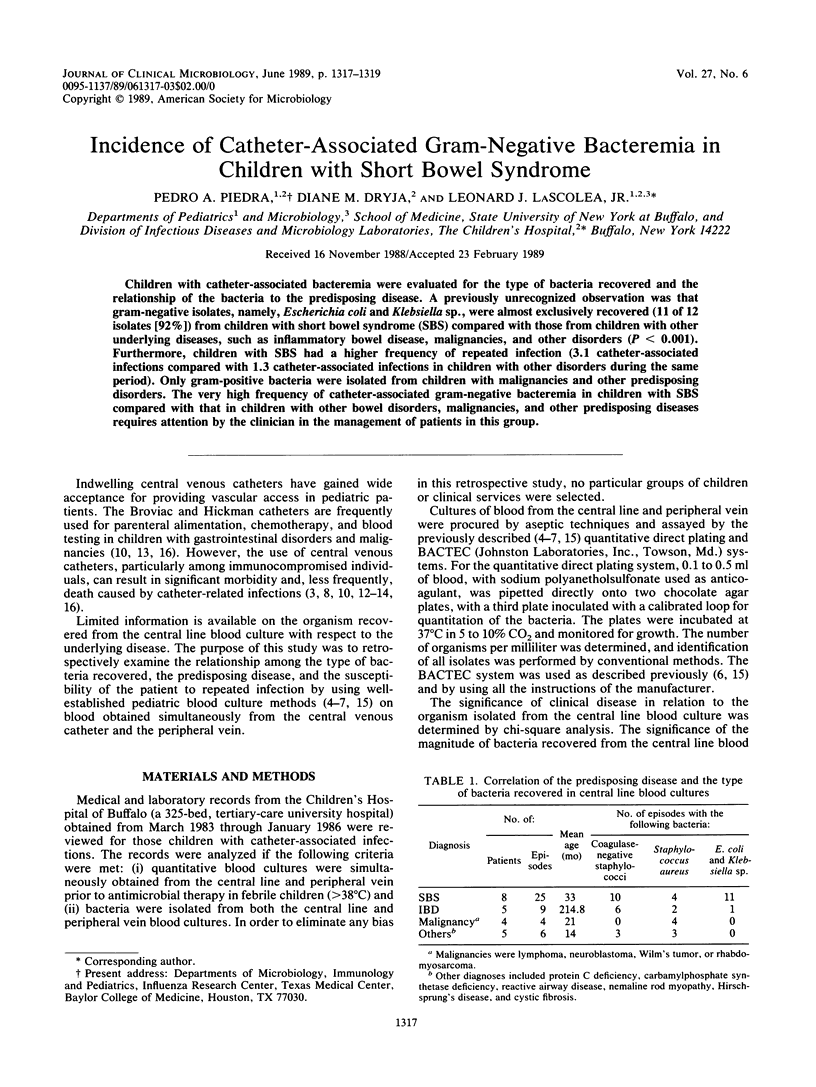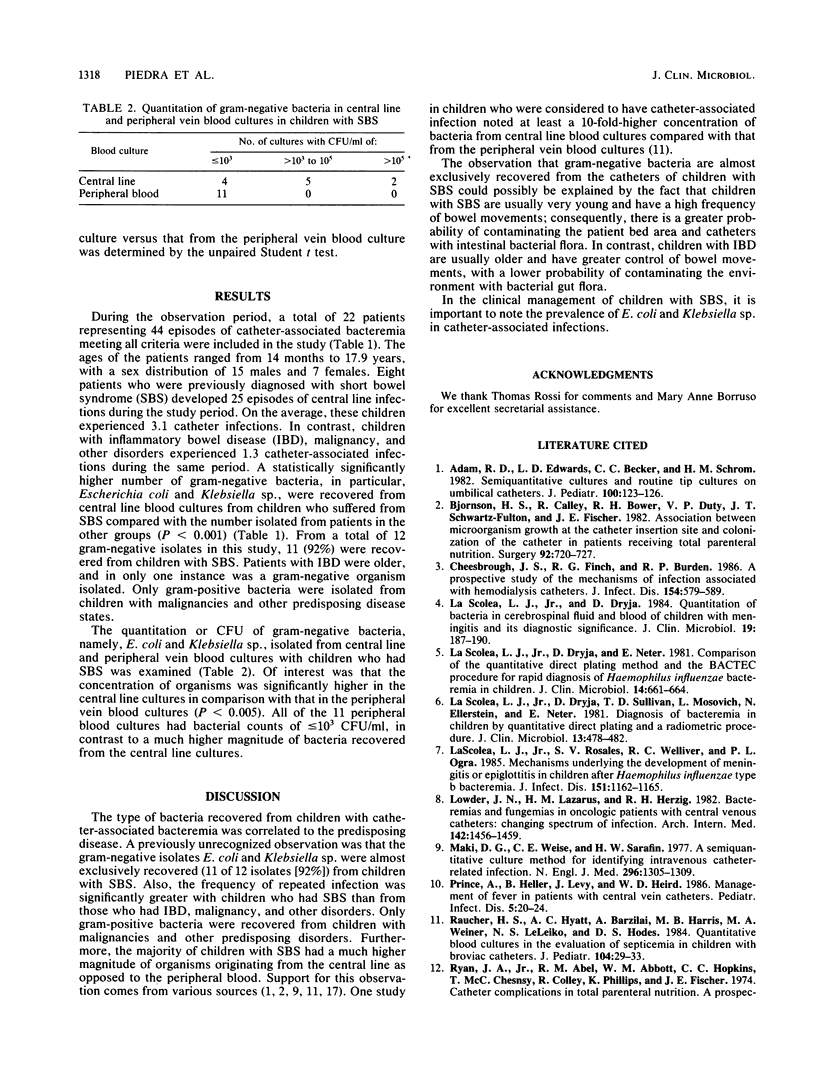Abstract
Children with catheter-associated bacteremia were evaluated for the type of bacteria recovered and the relationship of the bacteria to the predisposing disease. A previously unrecognized observation was that gram-negative isolates, namely, Escherichia coli and Klebsiella sp., were almost exclusively recovered (11 of 12 isolates [92%]) from children with short bowel syndrome (SBS) compared with those from children with other underlying diseases, such as inflammatory bowel disease, malignancies, and other disorders (P less than 0.001). Furthermore, children with SBS had a higher frequency of repeated infection (3.1 catheter-associated infections compared with 1.3 catheter-associated infections in children with other disorders during the same period). Only gram-positive bacteria were isolated from children with malignancies and other predisposing disorders. The very high frequency of catheter-associated gram-negative bacteremia in children with SBS compared with that in children with other bowel disorders, malignancies, and other predisposing diseases requires attention by the clinician in the management of patients in this group.
Full text
PDF


Selected References
These references are in PubMed. This may not be the complete list of references from this article.
- Adam R. D., Edwards L. D., Becker C. C., Schrom H. M. Semiquantitative cultures and routine tip cultures on umbilical catheters. J Pediatr. 1982 Jan;100(1):123–126. doi: 10.1016/s0022-3476(82)80251-5. [DOI] [PubMed] [Google Scholar]
- Bjornson H. S., Colley R., Bower R. H., Duty V. P., Schwartz-Fulton J. T., Fischer J. E. Association between microorganism growth at the catheter insertion site and colonization of the catheter in patients receiving total parenteral nutrition. Surgery. 1982 Oct;92(4):720–727. [PubMed] [Google Scholar]
- Cheesbrough J. S., Finch R. G., Burden R. P. A prospective study of the mechanisms of infection associated with hemodialysis catheters. J Infect Dis. 1986 Oct;154(4):579–589. doi: 10.1093/infdis/154.4.579. [DOI] [PubMed] [Google Scholar]
- La Scolea L. J., Jr, Dryja D., Neter E. Comparison of the quantitative direct plating method and the BACTEC procedure for rapid diagnosis of Haemophilus influenzae bacteremia in children. J Clin Microbiol. 1981 Dec;14(6):661–664. doi: 10.1128/jcm.14.6.661-664.1981. [DOI] [PMC free article] [PubMed] [Google Scholar]
- La Scolea L. J., Jr, Dryja D. Quantitation of bacteria in cerebrospinal fluid and blood of children with meningitis and its diagnostic significance. J Clin Microbiol. 1984 Feb;19(2):187–190. doi: 10.1128/jcm.19.2.187-190.1984. [DOI] [PMC free article] [PubMed] [Google Scholar]
- La Scolea L. J., Jr, Dryja D., Sullivan T. D., Mosovich L., Ellerstein N., Neter E. Diagnosis of bacteremia in children by quantitative direct plating and a radiometric procedure. J Clin Microbiol. 1981 Mar;13(3):478–482. doi: 10.1128/jcm.13.3.478-482.1981. [DOI] [PMC free article] [PubMed] [Google Scholar]
- La Scolea L. J., Jr, Rosales S. V., Welliver R. C., Ogra P. L. Mechanisms underlying the development of meningitis or epiglottitis in children after Haemophilus influenzae type b bacteremia. J Infect Dis. 1985 Jun;151(6):1162–1165. doi: 10.1093/infdis/151.6.1162. [DOI] [PubMed] [Google Scholar]
- Lowder J. N., Lazarus H. M., Herzig R. H. Bacteremias and fungemias in oncologic patients with central venous catheters: changing spectrum of infection. Arch Intern Med. 1982 Aug;142(8):1456–1459. [PubMed] [Google Scholar]
- Maki D. G., Weise C. E., Sarafin H. W. A semiquantitative culture method for identifying intravenous-catheter-related infection. N Engl J Med. 1977 Jun 9;296(23):1305–1309. doi: 10.1056/NEJM197706092962301. [DOI] [PubMed] [Google Scholar]
- Prince A., Heller B., Levy J., Heird W. C. Management of fever in patients with central vein catheters. Pediatr Infect Dis. 1986 Jan-Feb;5(1):20–24. doi: 10.1097/00006454-198601000-00004. [DOI] [PubMed] [Google Scholar]
- Raucher H. S., Hyatt A. C., Barzilai A., Harris M. B., Weiner M. A., LeLeiko N. S., Hodes D. S. Quantitative blood cultures in the evaluation of septicemia in children with Broviac catheters. J Pediatr. 1984 Jan;104(1):29–33. doi: 10.1016/s0022-3476(84)80584-3. [DOI] [PubMed] [Google Scholar]
- Shapiro E. D., Wald E. R., Nelson K. A., Spiegelman K. N. Broviac catheter-related bacteremia in oncology patients. Am J Dis Child. 1982 Aug;136(8):679–681. doi: 10.1001/archpedi.1982.03970440023006. [DOI] [PubMed] [Google Scholar]
- Sitzmann J. V., Townsend T. R., Siler M. C., Bartlett J. G. Septic and technical complications of central venous catheterization. A prospective study of 200 consecutive patients. Ann Surg. 1985 Dec;202(6):766–770. doi: 10.1097/00000658-198512000-00017. [DOI] [PMC free article] [PubMed] [Google Scholar]
- Sullivan T. D., LaScolea L. J., Jr, Neter E. Relationship between the magnitude of bacteremia in children and the clinical disease. Pediatrics. 1982 Jun;69(6):699–702. [PubMed] [Google Scholar]
- Wang E. E., Prober C. G., Ford-Jones L., Gold R. The management of central intravenous catheter infections. Pediatr Infect Dis. 1984 Mar-Apr;3(2):110–113. doi: 10.1097/00006454-198403000-00005. [DOI] [PubMed] [Google Scholar]
- Wing E. J., Norden C. W., Shadduck R. K., Winkelstein A. Use of quantitative bacteriologic techniques to diagnose catheter-related sepsis. Arch Intern Med. 1979 Apr;139(4):482–483. [PubMed] [Google Scholar]


